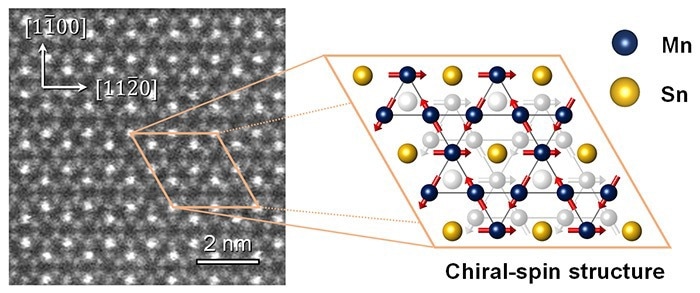In a novel class of magnetic materials known as non-collinear antiferromagnets, researchers from Tohoku University and Massachusetts Institute of Technology (MIT) have revealed a representative effect of the anomalous dynamics in action. On 3rd August, 2023, their findings were released in the journal Nature Materials.
 A cross-sectional transmission electron microscope image of the atomic arrangement of non-collinear antiferromagnet Mn3Sn (bright points for atoms) and chiral-spin structure composed of Mn atoms. Image Credit: Ju-Young Yoon, Shunsuke Fukami, and Luqiao Liu
A cross-sectional transmission electron microscope image of the atomic arrangement of non-collinear antiferromagnet Mn3Sn (bright points for atoms) and chiral-spin structure composed of Mn atoms. Image Credit: Ju-Young Yoon, Shunsuke Fukami, and Luqiao Liu
Modern society is fundamentally dependent on magnetic materials. Non-collinear antiferromagnets have received a lot of interest recently because of their fascinating characteristics that set them apart from traditional magnetic materials. The magnetic moments align collinearly in conventional collinear magnets.
In contrast, the moments in non-collinear ones create finite angles with one another. The octupole moment, which has been shown to be crucial for defining the unusual characteristics of the materials, is the single-order parameter that scientists can define for these non-collinear configurations.
The octupole moment, which rotates against the order parameters of general magnets, exhibits unconventional responses to electric currents, according to the researchers. It was discovered that such an anomaly was caused by a collision between electron spins and the distinctive chiral-spin structure of the non-collinear antiferromagnet.
Non-collinear antiferromagnet’s exotic physical properties give it wide-ranging potential for applications in information technology hardware. Our findings provide a fundamental basis for spintronic devices such as memories and oscillators.
Ju-Young Yoon, Study Lead Author and PhD Student, Tohoku University
Using the spin of electrons to electrically manipulate magnetism, or spintronics, is a multidisciplinary field that has the potential to speed up, reduce the size, and improve the efficiency of current electronic gadgets. Collinear ferromagnets—generally known as magnets—showed evidence of current-induced switching of magnetization around the year 2000.
This discovery prompted the recent commercialization of high-performance memory. Future low-carbon emission societies are anticipated to rely heavily on so-called Spin-Transfer Torque Magnetoresistive Random Access Memory (STT-MRAM).
The spintronics community is now heavily focused on non-collinear antiferromagnets. The chiral-spin structure of this material causes strong ferromagnet-like features, such as a huge anomalous Hall effect, despite its vanishingly low magnetization. It is known that the octupole moment, comparable to the magnetization of ferromagnets, can explain such events.
Although the dynamics of current-driven magnetization have been well known over the past 20 years, the dynamics of octupoles have not, necessitating a thorough examination.
To illustrate this, researchers looked at the Manganese-Tin (Mn3Sn) non-collinear antiferromagnet’s octupole moment response. They compared it to the magnetization of the ferromagnet Cobalt-Iron-Boron (CoFeB) by applying a magnetic field and an electric current.
While the switching directions for the magnetization were the same in the field-driven and current-driven examples, they were the reverse for the octupole moment in the non-collinear antiferromagnet.
They discovered via a more thorough study that whereas individual magnetic moments in the two systems rotate in the same direction, the assembled effect, caused by the particular chiral-spin structure of the non-collinear antiferromagnet, pushes the octupole moment in the opposite way.
Electrical control of magnetic materials is of paramount importance in spintronics. We have provided essential insights for controlling the non-collinear antiferromagnet, which is distinguished from its well-established counterpart, the electrical control of collinear ferromagnets.
Luqiao Liu, Professor, Massachusetts Institute of Technology
Professor Shunsuke Fukami from Tohoku University added, “Commercialization of STT-MRAM was achieved by a rigorous understanding of the interaction between magnetization and currents. In this regard, this work should form a solid basis for the development of functional devices with non-collinear antiferromagnets.”
Journal Reference:
Yoon, J.-Y., et al. (2023) Handedness anomaly in a non-collinear antiferromagnet under spin–orbit torque. Nature Materials. doi:10.1038/s41563-023-01620-2.